Chilli paste with a delayed action burn & could be as explosive as TNT

Chillies have always fascinated me for a very long time. There are literally thousands of varieties of chillies and I found out that they even grow chillies in England. Many Asians think that chillies are originally for Asia but I would like to remind them that chillies and chocolate originated form Mexico and Latin America . They have become so ‘traditional’ in our cooking that most of us have forgotten the history of our cooking traditions and traditional recipes. My first attempt at making preserved chillies was when I saw Jalapeño in Tesco last year. I bought a packet of them and when I got back home wondered what on earth I was going to do with them. I have this problem in that, I buy something and it will be in my refrigerator for the next two or three months before I get around to doing something with it … that is how I found out that nothing much lasts in the fridge for more than a few weeks. I did not want to waste the money spent on those Jalapenos so I made them into a sweet & sour preserve last Chinese New Year, February 5th 2011 to be exact. I can vouch for those Jalapenos as they are still on my cupboard shelf … actually they still look good even though I never had the occasion to try even one of them.
This time around I was going to make my own chilli sauce but knowing nothing about making chilli sauce I ran a couple of experiments based upon my lecithin experiments and then decide to call it chilli paste. The chilli paste recipe you see below is something I concocted from my knowledge of baking and low fat butter experiments. Actually the chilli paste recipe below could be modified into a low fat chilli paste butter recipe … if you think about it.
Chilli paste and chilli sauce
The basic difference between chilli paste and chilli sauce is their flow properties. Chilli sauce has a creamy watery property that allows it to flow out of a bottle where as chilli paste is quite solid and you will need a utensil to scoop it out of its container. Hence chilli past is normally found in wide mouth broad bottles where as chilli sauce is found in narrow neck bottles. The flow properties are controlled by the liquid or water content of the chilli mixture.
The homemade chilli paste recipe
| The Cooking Chilli Paste | ||||
| Item | Ingredients | Percentage | Weight | Weight |
| (%) | (g) | oz. | ||
| 1 | Dried Chillies | 100 | 100 | 3.52 |
| 2 | Carotino Oil | 75 | 75 | 2.64 |
| 2 | Olive Oil | 75 | 75 | 2.64 |
| 3 | Butter | 50 | 50 | 1.76 |
| 4 | Garlic | 60 | 60 | 2.112 |
| 6 | Corn Starch | 10 | 10 | 0.352 |
| 7 | Sugar | 10 | 10 | 0.352 |
| 8 | Salt | 4 | 4 | 0.1408 |
| 9 | Vinegar | 100 | 100 | 3.52 |
Photos of the homemade chilli paste process
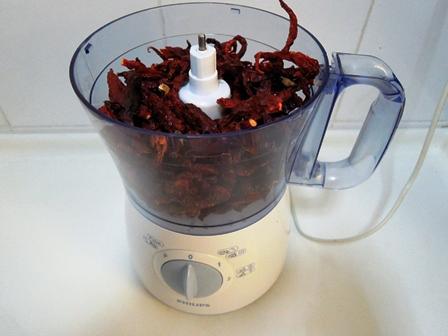
We begin by shredding the dried chillies in a food processor. Actually, in the previous two experiments I had carried out, I had used a scissors to cut the dried chillies up to create the chilli paste. Initially, I was not sure if it was possible to slice the dried chillies in food processor as they appeared to be too light.
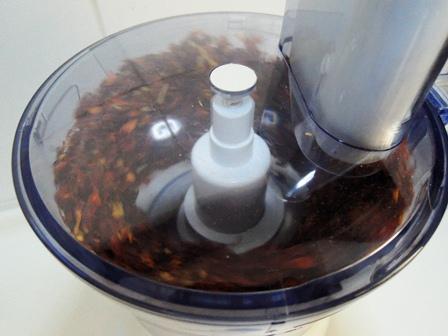
I let the food processor run for about five minutes or there about until it looked like fine enough pieces.
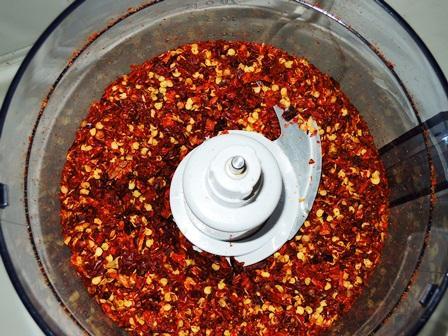
This looked fine enough. When I cut them with a scissors they were much larger pieces.
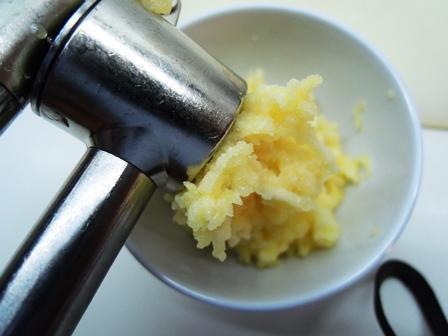
Crush up the garlic. You could use a broad knife to smash the garlic cloves by using the flat side of the blade to press down on the cloves of garlic and then chop them up. Don’t ever put whole garlic cloves in a blender and blend. If you do that the garlic will be blended with a horrid flavour. Some how blended garlic taste horrible and I do not know why. It is always best to crush garlic and this will result in the expected garlic flavour and aroma.
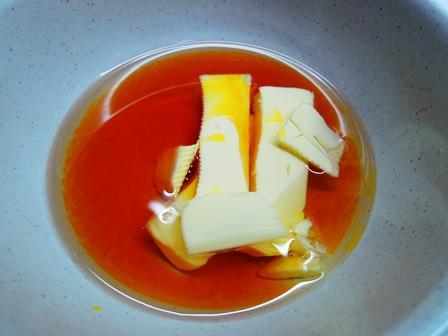
Here are the oil based ingredients. You can measure out the oils and butter into a separate dish. You could just use any cooking oil or just make the recipe with butter. That is replace the oils I used with butter. If you did that then you would have a butter chilli paste which needs to be kept in the refrigerator or else the butter would go rancid after a few days. I had used two different oils for nutritional reasons. Carotino oil is very rich in the Vitamin E compounds and virgin olive oil is good for the skin (my personal experience). I would have added virgin coconut oil but I have run out of vco and need to make some more.
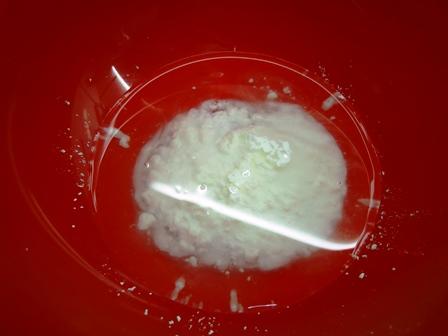
Here is the water soluble ingredients. I mixed them all up together, the sugar, salt, corn starch and vinegar. Notice that I did not add water. Vinegar is about 97% water and that is the reason I had not added any water. You could add more water and make it less of a chilli paste. Stir them with a spoon until the sugar, salt and corn starch dissolves. You can feel with a spoon that the sugar has dissolved.
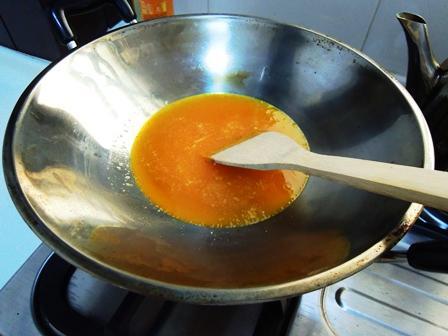
Place the oils and butter in a frying pan or a wok and heat it up. You really want to cook the chillies to make chilli paste.
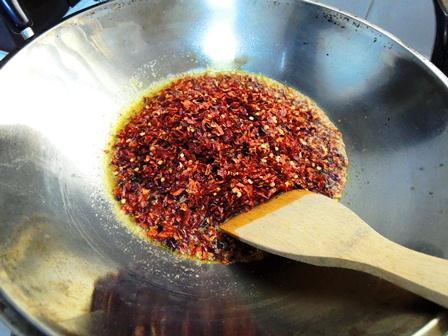
Fry the dried chillies in the oil and butter. Cook them well or else there will be a slight raw taste. I had fried them for about five minutes on a medium to high flame but I think the five minutes was not enough.
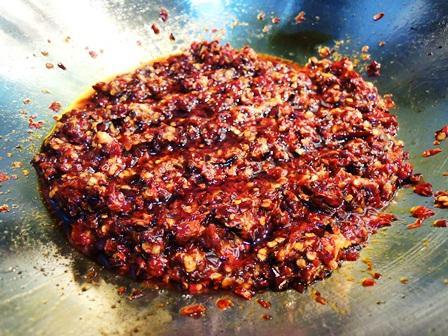
I forgot to photograph when I added the garlic mash. It depends on your taste. I like the almost raw garlic flavour so I added it in at the last moment before switching off the fire. Some of you may want to add it in earlier and let it cook well. After that I poured in the corn starch solution and cooked it until it thickened. You will see there is some excess oil along the outer edges of the chilli paste – see the orange liquid in the top of the chilli paste in picture . Let the chilli paste cool for half an hour or one to two hours and the oil will be absorbed into the chilli paste. Cover the chilli paste while it is cooling so that no dust, bacteria or fungal spores, which are always in the air, settle on the chilli paste.
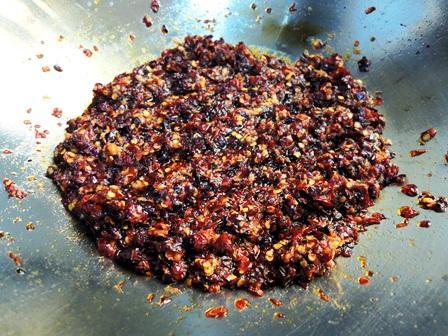
As you will observe most of the oil has been re-absorbed into the chilli paste.
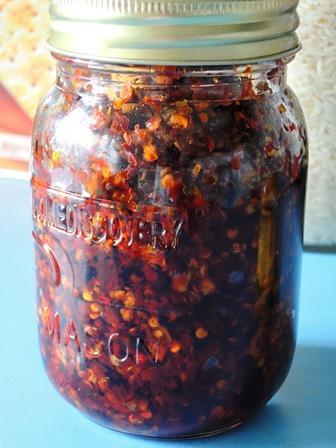
Bottle the chilli paste in a clean bottle that has a wide mouth. I must apologise as I think this recipe needs a lit more salt.
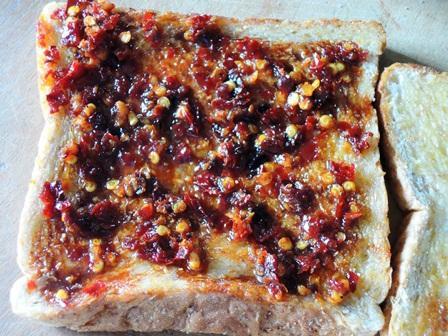
I had Marmite and chilli paste for breakfast this morning. You will never know how good it is until you try it. The Marmite gives it a tang and the chilli paste gives it a hot hot bite, if you chew slowly.
I did not mention why I had called a delayed action chilli paste, did I? This recipe has a delayed action. When you put the chilli paste in your mouth you will find it a bit bland for the first few seconds. Just wait a while and the burn will set in. That means if you are in the habit of eating your food very quickly you will not find this chilli paste hot but if you take your time to chew your food well … well even TNT will not be as explosive as this chilli paste.
Please do click on the facebook and Google+ like buttons if you found this article informative and useful.
This article on How to make chilli paste – delayed action TNT was researched and written by Peter Achutha
Leave a Reply